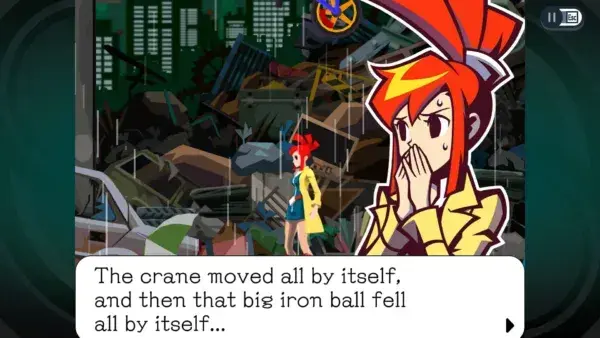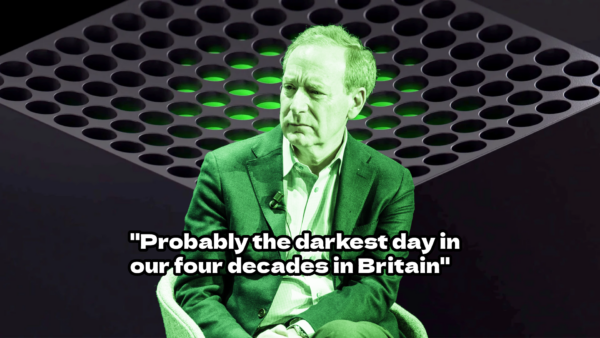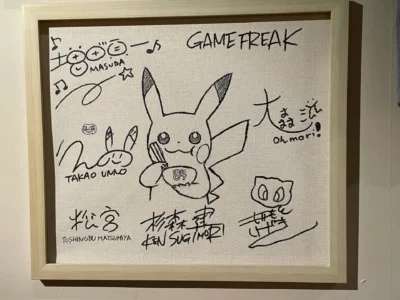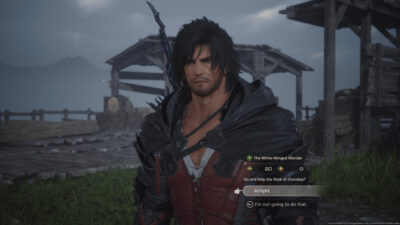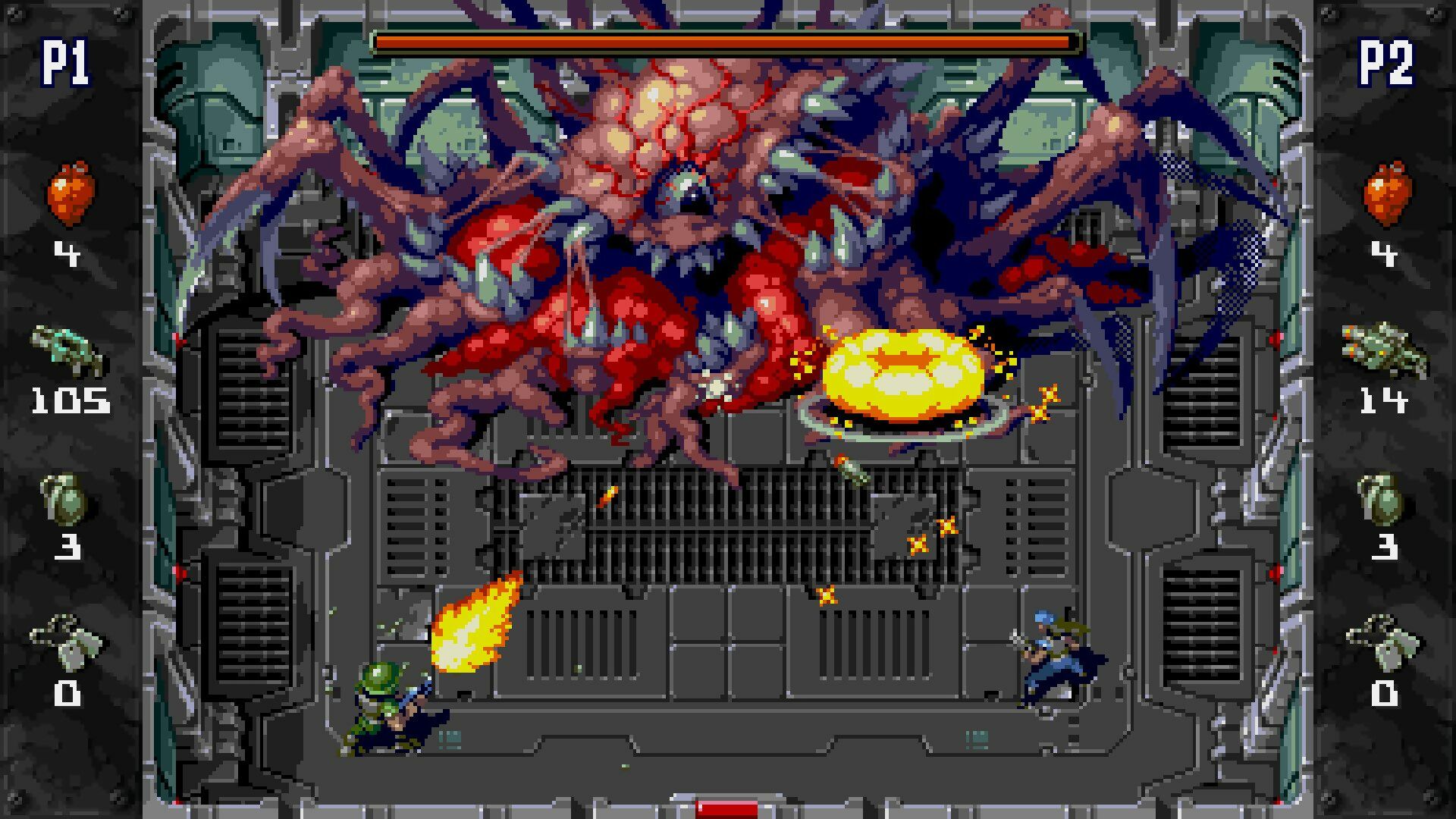
Years after its nineties heyday, the Sega Mega Drive is still getting new games. We chat with some of the people behind its thriving indie dev scene.
For three months in the autumn of 2019, the offices of British indie studio Bitmap Bureau were turned into a miniature production line. In one part of the room, developer Matt Cope was flashing data onto PCBs, before handing the boards over to co-founder Mike Tucker, who assembled the cartridges, applied the labels, and placed them into boxes. Then those boxes would have to be parcelled up to be sent to the local Royal Mail depot for shipping. “It was a big process, and there were some days where we’d be absolutely shattered, preparing all these packages,” Tucker recalls. “You’re burning it to the depot for 5pm, and you can’t even see out of the car windows because it’s so full of bags.”
“One time,” Cope chips in, “he did about five or six runs to the post office. And then the guy there goes, ‘Oh, if you had this much to send, we could have sent a truck to pick it up…’”
So went the three months that straddled the release of Xeno Crisis, Bitmap Bureau’s modern release for the Sega Mega Drive. An homage to the likes of Smash TV and Alien Syndrome, it’s a frantic top-down shooter that appears to push the console’s ageing hardware to its limits. Xeno Crisis’s latter stages of development were crowdfunded by a Kickstarter, which began in late 2018, and the developers were surprised by the scale of the demand. “In all honesty, we were doing the Kickstarter for a bit of fun,” Cope says. “If we sold 100 copies, then great, happy days. We’ll just make them ourselves by hand.”

Instead, Xeno Crisis got orders of over 700 from its Kickstarter campaign alone, either for the cartridge by itself, a boxed version with manual, or a special edition with exclusive artwork.
As Bitmap Bureau’s experience demonstrates, Sega’s 16-bit console still has a devoted fan base, and in the past few years it’s been joined by a small but equally dedicated community of indie developers. One of the early pioneers in this regard was Pier Solar and the Great Architects, which began as a small fan game but gradually grew in scale until it was released as a physical cartridge for the Mega Drive in 2010. More recently, we’ve seen the likes of Tanglewood, Demons of Asteborg, Tänzer, and The Cursed Knight, all released in the same cartridge format that previously appeared in shops in the early nineties.
Just about all the developers we spoke to cite SGDK – or Sega Genesis Development Kit – as one of the driving forces behind this Mega Drive development scene. As its name implies, SGDK provides a modern environment for developers to make games in the C language, and provides all the libraries and resources needed to compile that code and output it as a readable ROM image that will run on the console’s original hardware. “It would have taken way longer to get started, and way longer to develop the game to completion,” says Mikael Tillander, developer of the Mega Drive hack-and-slash, Tänzer. “To be honest, I don’t think I would have done a complete game without it.”
“SGDK is the reason so many people can make games on the Mega Drive, concurs programmer Arnaud Tamarais. “Without SGDK, there would be no Cursed Knight.”

Like so many of the games made for the Mega Drive in the past five to ten years, SGDK began as a passion project. In the late nineties, Paris-based programmer Stéphane Dallongeville created a Mega Drive emulator, Gens. When it came to developing dedicated Mega Drive ROMs, meanwhile, Dallongeville looked around on the web and was surprised at the lack of quality tools for the console. He didn’t fancy coding in Assembly – the language many Mega Drive games were originally written in – and couldn’t find a dedicated C compiler. “It’s why I started to set up my own development environment by compiling recent GCC [GNU Compiler Collection] capable of generating m68k-elf code with a specific link script for the Sega Mega Drive,” Dallongeville tells us. “So I finally had a working C compiler and could start writing my own code in a much more efficient way.”
Dallongeville has regularly built on and improved SGDK ever since, working on the project between his day job as a software developer in the medical industry. The first public build appeared in 2006. “I was really surprised by how well received it was,” he says. “That really pushed me to improve it.”
Indeed, SGDK has proven so useful that its usage has spread beyond the indie dev community. On the Mega Drive Mini 2 retro console released in late 2022, you’ll find Fantasy Zone – a new port of the arcade shooter developed using SGDK. For Dallongeville, who spent many late nights and weekends developing SGDK – and still updates it today – its widespread use is a welcome surprise: “The Mega Drive is a very old system, and programming for it is just a hobby for me… it’s crazy and awesome at the same time to see some kind of ‘professional’ games being made with it – and even Sega officially distributing games being made with it!”
For many of the developers we spoke to, making a game for the Mega Drive goes beyond nostalgia: rather, a common motivation was challenge. The console was first released in 1988, making its hardware painfully limited by modern standards; to make a game for the Mega Drive, you have to first consider its palette of 512 colours, the 80 sprites it can handle per frame, and the space available on a cartridge. Bitmap Bureau, for example, had to cram Xeno Crisis into just 4MB of RAM.
“I kept a spreadsheet that had a ridiculous amount of tabs and detail,” says Cope. “That was the hub of the technical aspects. Because, if you pull too much from one area, you cause a problem somewhere else. If you use too many sprites, then you’re probably going to need to store more tiles in memory, then if you push DMA [Direct Memory Access] too much, then you haven’t got time to do other things in VBlank. Then you start layering in music, sound effects, and so on… to fit that all in four megabytes was pretty hard.”
Cramming Xeno Crisis into that limited space required plenty of optimisation – and a bit of design trickery that would easily go unnoticed in the midst of the action. First: each player can only have eight bullets on the screen at one time. Also: only eight aliens. In fact, this latter rule can be used as a tactical advantage by cannier players, since hostages occupy the same sprite slots as aliens, so if there are two hostages on the screen, the game will only spawn six aliens. “It’s like a little tactic,” Cope says. “You have less to deal with if you kill the aliens and then you get the hostages at the end.”

Limitations aside, the Mega Drive has an appeal to indie developers because, compared to other systems of its vintage, it’s relatively easy to make games for. So says Mike Rouse, a veteran game developer who regularly shares news of the latest Mega Drive titles on his YouTube channel, Retro Gamer Boy. “There’s two things: there’s SGDK and then the architecture of the machine and how friendly it is,” he tells us. “Those two things combined mean that you’ve got this huge pool of developers who are now capable of creating something for the console. It’s probably one of the primary reasons why there’s this resurgence in Mega Drive development over something like the Super Nintendo, which requires a more refined, almost lost skill set. Whereas what SGDK has done is democratised development for the console, which is fantastic.”
“The SNES is a beast of its own,” concurs Cope. “There are very limited, high-quality compile chains around for it. I tried porting the Xeno Crisis code to various compilers, and I could get it to the point where the code will compile, but it won’t link. Basically, the way memory banks behave is much more complicated than the Mega Drive. Also, the processor isn’t as performant in some ways. They both have pros and cons, but the Mega Drive is really great to cut your teeth on.”
What’s most noteworthy about the recent crop of indie Mega Drive games is just how technically accomplished they are. Xeno Crisis’s graphics and sound, with detailed pixel art by Henk Nieborg and pounding music by Savaged Regime, are on a par (if not superior) to those seen in games released in the console’s heyday. Similarly, French developer Neofid’s Demons of Asteborg, a hack-and-slash platformer in the vein of later Castlevania titles, brims with smooth animation and intricate sprite designs. Then there’s Paprium, a brawler developed by WaterMelon – the studio behind Pier Solar. Its making and release were mired in a series of controversies too complex to detail here (“I’m still waiting for my copy,” says Rouse), but there’s no denying what its creators achieved: its hulking sprites look like they belong on a more powerful machine like the Saturn or Neo Geo.
There are several reasons for the quality of these and other recent games. First, there’s the time factor: Tänzer, Xeno Crisis, and Demons of Asteborg may be made by smaller teams on low budgets, but developers in the eighties and nineties were often expected to create their games to extraordinarily tight deadlines. Cartridge space is another factor: 30 years ago, the price of ROM chips meant that developers were often asked to squeeze their games into just a few kilobytes.
When programmer Yuji Naka ported arcade hit Ghouls ’n Ghosts to the Mega Drive, for instance, he was originally expected to squeeze the thing onto a 4Mb cartridge – the equivalent of 512kB of memory. After a bit of pleading, his bosses let him up the cartridge capacity to 5Mb, or 640kB, instead. Naka created a terrific port of the game, but still had to cut corners to make things fit: backgrounds are composed of more repeating tiles, and the palette has been reduced to save space.

Modern games for the Mega Drive are often many times larger than that 640kB Ghouls ‘N Ghosts cartridge; Paprium, say, takes up 8MB of memory. To get an idea of how Ghouls ‘n Ghosts might have looked had it been blessed with a similarly generous helping of memory to play with, check out aMaru’s work-in-progress on YouTube (wfmag.cc/amaru). It’s essentially a ROM hack that reworks Naka’s port and uprates its graphics to more closely match those of the arcade version. It’s but one example of what can be achieved with enough time, memory, and understanding of what can be done with the Mega Drive’s architecture.
“Now there are decades of know-how that’s been assembled on the internet,” Tänzer’s Mikael Tillander points out, “so information on how to do savvy tricks is easy to get hold of. But you still need to pull it off, so it needs the right person for the job as well.”
As several developers describe, the Mega Drive indie scene is truly international, with developers located from all parts of Europe to Brazil to Russia. “Brazil has one of the most vibrant set of developers out there for the Mega Drive,” says Rouse. “There’s a huge passion for the console, because it’s still culturally relevant in Brazil – it was five, six years ago that they released the Mega Drive again. And Russia as well – you can still walk into a shop and buy a Mega Drive [clone]. There’s still a vibrant indie scene in Russia that doesn’t break out into the rest of the world, but a lot of that is because they’ll make Mario games for the Mega Drive and stuff like that. But there’s the PSCD guys, who are actually Russian and Ukrainian; they go to developers and say, ‘We’ll take your existing game on Switch and bring it out for the Mega Drive.’”
One name that often comes up in our conversations is Sik, an Argentina-based developer who’s made the top-down shooter, Arkagis Revolution. “Its rotating mechanic is really smart,” says Tillander. “Not many people apart from Sik could have pulled that kind of thing off.”
“Sik’s created a number of games over the years, and is probably one of the nicest guys on the scene,” says Cope. “And so knowledgeable – if I’m ever doubting anything on the Mega Drive, I’ll ask him.”
Cope highlights something else about the Mega Drive indie scene here: the sense of community. When Matt Phillips was developing his Mega Drive game, Tanglewood (see box), Sik provided technical assistance, as he later did on Xeno Crisis. Bitmap Bureau and Demons of Asteborg developer Neofid support Dallongeville’s ongoing work on SGDK, and vice versa. Says Dallongeville, “Bitmap Bureau have donated since they started development on Xeno Crisis and still are, Neofid Studios donated and they also hire me as a consultant to help them with the development of their games. I also received some generous donations from different people just wanting to help and support SGDK development. So yeah, the community is, for the most part, really supportive.”

“It’s great to see it grow up – there’s loads of people jumping in,” Cope says of that community. “And we don’t see that as a negative. Some people might think, ‘We don’t want any more competitors’, but the reality is, it’s so bespoke, what we’re doing, that the more of us there are involved, the more it helps makes things more accessible, like the cartridges, the shells; the more people are buying those, the more people will be selling them… it grows the customer base.”
Indeed, that growing customer base has seen the rise of companies like France’s Broke Studio, which specialises in making physical releases for old consoles, including The Cursed Knight and Arkagis Revolution for the Mega Drive. While there are still challenges to overcome – Cursed Knight programmer Arnaud Tamarais recalls that the game didn’t work on a particular version of the Mega Drive, requiring some late-night bug hunting – the process of getting physical games made has become somewhat easier in recent years as the audience for them has grown.
Back in 2019, Bitmap Bureau’s Matt Cope and Mike Tucker were ordering PCBs, cartridge shells, and boxes, then doing much of the production line labour and packaging themselves. “We were sending stuff out to influencers in the early days and packaging each one individually, handwriting the labels,” says Tucker. “We’ve learned a lot since then. And luckily, we don’t really have to do much in the way of manufacturing anymore, which is good. We can actually write some code and make some games!”
The Mega Drive indie scene doesn’t look like it’s going anywhere, either. While there aren’t quite as many projects for the console on Kickstarter lately, many of the developers we spoke to had sequels in the works or had upcoming games to recommend. Tillander is working on the side-scrolling shooter ZPF, which looks like a modern riff on such nineties classics as Gynoug and Lords of Thunder. Tamarais and his collaborators at GGS Studio Creation are working on a run-and-gun sequel, The Cursed Legacy, with a demo due for release in 2023. Neofid is putting the finishing touches to its Demons of Asteborg follow‑up, Astebros.

Then there’s veteran composer Yuzo Koshiro, who in November 2022 announced that he was working on a 2D shooter for the console.
Rouse recommends Black Jewel Reborn, a side-scrolling hack-and-slash successfully crowdfunded in July 2022. In fact, Rouse has his own Mega Drive game in “super, super early” development – a cyberpunk-themed, RPG tactics title, though it probably won’t be appearing on a console near you for a while. “My day job destroys my ability to work on anything,” he says. “I’d need to bring two or three other people to help me build it.”
As for Bitmap Bureau, it’s also preparing to return to the alien-infested world of Xeno Crisis, having spent the last few years making the top-down hack-and-slash Battle Axe and Neo Geo brawler, Final Vendetta. “We’re very early on with that, really,” Cope says of their sequel to XenoCrisis. “We’re at that point where we’re looking forward to doing it. When you finish a game, you don’t want to necessarily work on something exactly the same again.”
“Yeah, we’ve had Xeno Crisis 2 in the back of our minds for a long time now,” Tucker says. “We’ve had a nice break from the original and we’ve got loads of ideas.”
Work on Xeno Crisis 2 is set to begin this year – almost 35 years after the first Sega Mega Drives rolled off the production line in Japan. The console may be far from the technological cutting edge, but the development scene surrounding it is a vibrant and growing one


